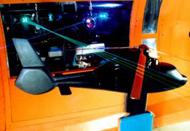50 years of laser research at Onera
Since its invention in 1960, applications of the laser have multiplied constantly. Research in aeronautics hasn't been left out, and lasers are now an essential tool for studying and understanding turbulence, analyzing combustion and observing pollution. A short tour around laser research at Onera.
Number 42
|
|
The laser is 50 years old. It was on 16th May 1960 that the American Theodore Maiman produced the first laser in an aerospace laboratory, the Hugues Research Laboratory at Malibu in California. At the time no one imagined how many applications of this instrument would be possible, and it was merely a laboratory curiosity. Very soon however Onera became interested, and by 1964 had acquired its own laser. |
|
"We very quickly saw the possible applications in our research work, particularly for measurement", recalled Jean-Pierre Taran, Onera's living memory on the subject, who had worked in the United States with one of the discovers of the laser, Charles Townes. He had posited the concept of the laser in 1958 and was awarded the Nobel prize for physics in 1964. "Lasers are unbeatable tools for our research work, and we had to understand how they worked to improve them. This was how we became pioneers of their development in France". Onera is involved in all types of laser research activity, from the most fundamental through to the most applied. A laser pioneer |
|
| The field of application is essentially measurement. Starting in 1965, Onera developed a laser based interferometric method to calibrate its ultra-sensitive micro-accelerometers, instruments designed to measure the infinitely small accelerations of some space capsules. A little later Onera also developed a patented method of real-time measurement of the composition and temperature in the combustion chambers and other reactive environments like plasmas without disturbing the flows or chemical reactions. Another invention: devices to measure the speed of gas flows e.g. around an aircraft model. For this, small particles are introduced into the gas flow, and we measure their speed by "filming" them using laser impulses of a few micro-seconds. | 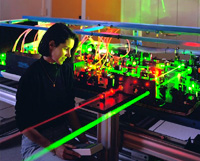 Simultaneous measurement of temperature and concentrations of radicals by DRASC (coherent Raman Anti-Stokes diffusion) and by fluorescence using three synchronized lasers – Onera/SOPRA resonating DRASC bench |
|
It is this type of technique that has thus been used to obtain the temperature and pressure of the gas around the model. "We have been able to better understand the turbulences, and obtain a lot of information in the flows" explains Jean-Pierre Taran. For these instruments Onera has developed more powerful lasers, "tunable" colored lasers in particular, with adjustable wavelengths. These have been marketed widely. Up until the first years of the 2000s Onera was building so-called "CO2" lasers, continuous and low-power for anemometry (measuring the speed of gases), as well as very high-powered chemical lasers and electrical discharge lasers for military applications. Today, research into lasers and their applications continues, on extremely diverse subjects. Understanding combustion |
|
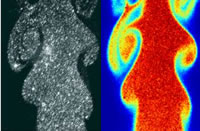 Simultaneous measurements of the fluctuations of speed (using particle imaging – PIV) and temperature (with laser induced fluorescence – PLIF) are used to determine the heat transfers due to turbulence (thermal turbulence). |
How do gases behave during combustion, or during a supersonic flow? The question is crucial for improving engine performance, and also for the reduction of pollution and noise. Hence the importance of measuring in situ which gases react, which are formed, and also the temperature and pressure, and all this at every point of the combustion chamber. How this data changes during the combustion phenomena also has to be studied, all of which may last only fractions of a second. "Until now the lasers we have been using, powerful enough for these measurements, emitted impulses every 10 milliseconds, explains Emmanuel Rosencher, scientific director of the Physics branch at Onera. But, turbulence phenomena, that remain one of the great mysteries of fundamental physics, occur over periods of time that are shorter than a millisecond. |
|
So to understand turbulent behavior we are going to use lasers having repetition frequencies that are much higher, that can be used to explore phenomena lasting less than a millisecond". Seeing through the fog |
|
| Even quicker lasers, called "femtosecond" lasers (with an impulse duration of a few billionth of a millisecond) may help to see through a very opaque milieu, such as thick smoke or fog. In fact, these types of milieus don't stop the light. It is simply that each photon (grain of light) is absorbed and then reemitted by the particles that are present (water droplets in the case of fog, soot ands ash in the case of smoke). | 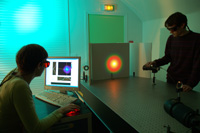 Experimental device installed for the study of the filament propagation of femtosecond lasers in a turbulent atmosphere. |
|
Observing turbulence |
|
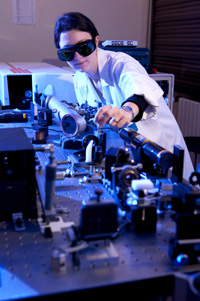 Laser and OPO bench, emitting at 2.5 µm for Lidar applications. |
Aircraft create turbulence, and this is dangerous for anyone following too closely. These atmospheric agitations generate very strong mechanical stresses that may damage an aircraft's structure. This is why, during takeoff and landing, the rules of aerial navigation insist on a minimum distance between two aircraft. It is very important to understand these turbulences better, to reduce the dangers, and so possibly to increase the frequency of aircraft taking off. These vortices are studied using Lidars, a technology based on the transmission of a laser beam and the analysis of the luminous radiation sent back by the milieu being studied1. "The progress made in the visualization of these vortices is staggering" emphasizes Emmanual Rosencher. "Before, specialized lasers were needed, and they were very heavy. Today, we are using optical components developed for telecommunications so we will be able to install vortex detection systems at all airports, even on each aircraft". |
|
|
|
|
Lidars can also be used to analyze the chemical composition of certain gases, to understand their combustion for example, or to detect pollution. Instead of using a laser of a single wavelength for this Lidar, we send a large number of wavelengths so that we can analyze a number of chemical species at the same time. "This type of Lidar has been implemented with three generations of laser" explains Emmanual Rosencher. "The "grandfather" was the conventional laser, with a single frequency. The "father" is the optical parametric oscillator (OPO), a compact device, robust and efficient energy consumption, and which allows the sweeping of frequencies. |
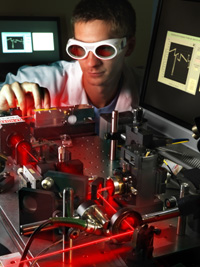 Compact optical parametric oscillator (OPO) for the detection of chemical species |
Finally, the putative "son" is the "frequency comb laser", a technology that can be used to produce millions of different laser frequencies, with great spectral precision, using compact lasers." These are the result of very recent work for which the German Theodor Hänsch was awarded the Nobel prize in 2005. They are having a spectacular impact on the chemical analysis market. |
|
|
|
|
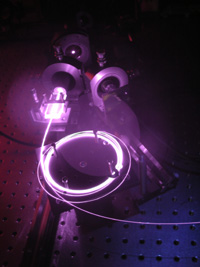 Testing fibers of the Institute of Photonic Technology at the Onera laboratory, for the detection of wake vortices from a following aircraft |
New laser sources have to be found and developed for all this research. This is the case, for example, with the optical parametric oscillators already mentioned, for which Onera has designed new "non-linear" materials, as well as new optical architectures, made up of nested cavities. "We have also developed laser sources based on fiber optics: by cleverly doping these fibers, we can guide the light within the fiber very effectively explains Emmanual Rosencher. And so we avoid having to align mirrors to guide the light, which greatly simplifies the instruments, with the result that they are more robust. For aerospace applications in particular, this is crucial". |
|
Cécile Michaut, scientific reporter 1 : An expert speaks out : Turbulence detecting lidars |
|
